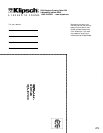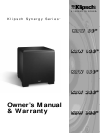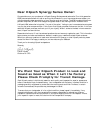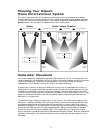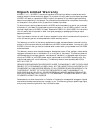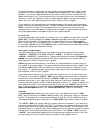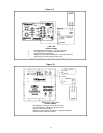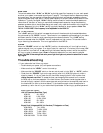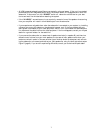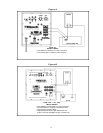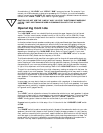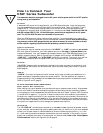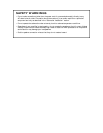For parallel connection of subwoofer and main speaker wires (main speakers full range), connect
the subwoofer wires to the secondary set of speaker terminals (speaker B) if your amplifier is so
equipped. If you use your speaker B terminals, they must be internally wired in parallel with the
speaker A terminals or you’ll notice a dramatic drop in the volume level of your main speakers. If
this occurs, connect your subwoofer wires to the same amplifier speaker terminals that are being
used to drive your main speakers (parallel connection). Refer to Figure A (page 8).
If your amplifier is not compatible with low impedance speakers, this type of parallel connection
should not cause any operational problems. The input impedance of the KSW subwoofer’s “HIGH
LEVEL” inputs is a very high 510 ohms. Because of this, your amplifier will primarily see the
impedance load of your main speakers. Please consult your dealer for details regarding connection
of multiple speaker cables to the speaker outputs of your specific amplifier.
HI LEVEL OUT
If a limited range signal (bass filtered) is to be sent to your main speakers, connect them to the “HI
LEVEL OUT” terminals instead of the main or front channel speaker terminals of your amplifier.
Refer to Figure B (page 8). The high pass filter on these outputs will filter out bass frequencies
below 100 Hz from your main speakers (120 Hz, KSW 50). Also refer to the “LOW PASS” section
for more detail. Do not connect the HI LEVEL inputs of another subwoofer to these outputs as they
are high pass filtered (bass frequencies removed).
LINE LEVEL CONNECTIONS
The KSW subwoofers are equipped with two types of line level connections. They are labeled:
“LINE IN” / “LINE OUT” and “SUB” (KSW 300, “LFE IN”). The KSW 50 is equipped with
“LINE IN”/“LINE OUT” connections only. These connections should be made using high quality
shielded interconnect cables terminated with RCA phono plugs (consult your Klipsch dealer for
recommendations). Refer to Figures C and D (page 9).
LINE IN jacks should be connected to a non-filtered, full-range subwoofer or pre-amp output on
your receiver or pre-amp/processor. This signal contains the normal bass information present in the
main left and right channels. When connecting to a component that has only a single pair of pre-
amp outputs, “Y” adapters (splitters) may be used to feed a signal to both the subwoofer and the
power amplifier. Refer to Figure D (page 9).
If your electronics provide you with a mono subwoofer output and you will not be connecting an
LFE channel, you can use the “LFE IN”/“SUB” jack and a single interconnect cable to connect to
the subwoofer. Note: Since the KSW 50 lacks a “LFE IN”/“SUB” jack, you can connect the mono
subwoofer output jack on your electronics to either the left or right channel “LINE IN” inputs.
However, there is a significant (6 dB) increase in subwoofer volume if a “Y” adapter is added to the
mono subwoofer output of your electronics and both the left and right “LINE IN” jacks are fed a
signal. This also applies to all other KSW models. These types of hookups will provide a full-range
signal to the main speakers. Refer to the “LOW PASS CONTROL” section for more detail.
LINE OUT
If a limited range (bass filtered) signal is to be sent to your main speakers, connect the “LINE
OUT” jacks to the inputs on the main or front channels of your power amp, receiver or integrated
amplifier. These outputs will remove frequencies below 40 or 80 Hz (120 Hz, KSW 50) from your
main speakers depending upon the setting of the “HIGH PASS” switch. Refer to Figure C (page 9).
The “LFE IN”/“SUB” jack (except KSW 50) is typically used with the newest 5.1 (six channel) sur-
round sound systems (Dolby Digital
®
and DTS
®
). It is a discrete, low frequency effects channel with
different signal content than the bass frequencies present in other channels. The information in this
channel can be up to 10 decibels louder than the bass signals in other channels, so caution should be
exercised when initially adjusting the subwoofer’s level control. The “LFE IN”/“SUB” input and
“LINE IN” inputs are summed together so both connections may be used concurrently if your elec-
tronics provide you with both outputs. Refer to Figures B, C and D(pages 8 and 9).
4



